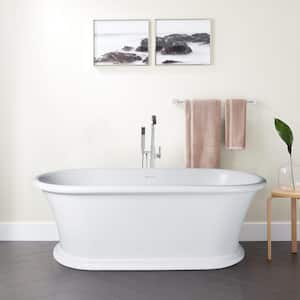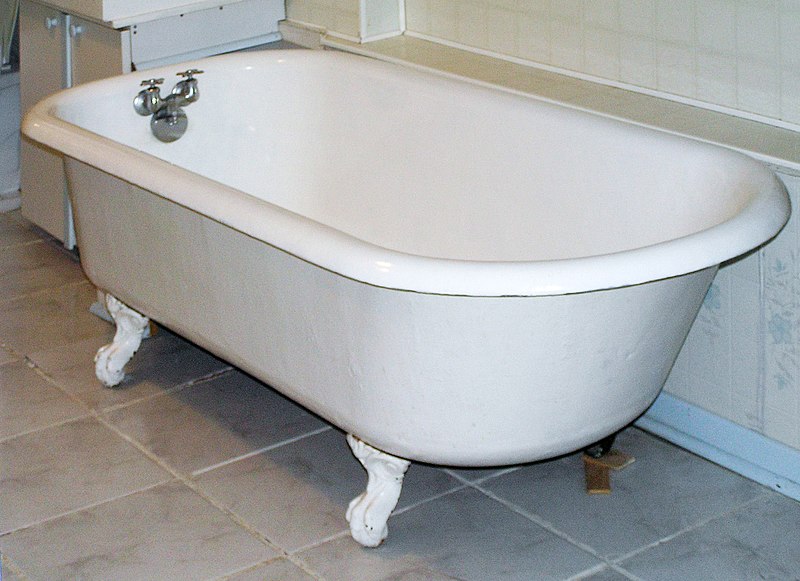Just How To Replace A Bathtub (For Beginners).
Just How To Replace A Bathtub (For Beginners).
Blog Article
Everyone is bound to have his or her own theory involving How to Install a Bathtub Yourself.

Installing a tub isn't precisely rocket science, however it does need solid plumbing, woodworking, as well as often, tiling skills. Replacing an old bath tub with a new one is also a reasonably challenging task. If the old tub is conveniently accessible, the job can move immediately; if you have to open up a wall to get rid of the old tub as well as position the new tub, the job is much harder. In either instance, the project is within a house handyman's skills, although you will certainly need an assistant to leave the old bathtub as well as embeded in the new one. Make certain you have actually qualified on your own for the job as well as fit attempting it. Instead of working with a professional to take control of a halfway-completed task, it is better to consider utilizing one before you start. Chances are you may need a specialist plumber to make tube links.
This article will aid you mount a new bathtub in your washroom if you have actually already purchased a new bathtub and also do not need to change the plan of your previous water system pipelines.
Your tools as well as material checklist need to consist of the following:
Getting ready for the Installment
Firstly, the supporting structure supplied with the bath must be fitted (if called for) according to the manufacturer's instructions. Next off, fit the taps or mixer to the bath tub. When fitting the faucet block, it is essential to make certain that if the faucet comes with a plastic washing machine, it is fitted between the bathroom and the taps. On a plastic bathroom, it is likewise sensible to fit a supporting plate under the faucets system to prevent pressure on the tub.
Fit the flexible faucet connectors to the bottom of the two taps making use of 2 nuts and also olives (occasionally provided with the bathtub). Fit the plug-hole electrical outlet by smearing mastic filler round the sink electrical outlet opening, and after that pass the outlet through the hole in the bath. Use the nut supplied by the manufacturer to fit the plug-hole. Analyze the plug-hole electrical outlet for an inlet on the side for the overflow pipeline.
Next off, fit completion of the adaptable overflow pipeline to the overflow electrical outlet. Afterwards, screw the pipe to the overflow face which ought to be fitted inside the bath. Ensure you use every one of the provided washers.
Link the trap to the bottom of the waste outlet on the bathtub by winding the string of the waste electrical outlet with silicone mastic or PTFE tape, and also screw on the trap to the outlet. Connect the bottom of the overflow tube in a comparable manner.The bathroom must currently prepare to be suited its last setting.
Removing Old Touches
If you require to replace old taps with new ones as a part of your installment, after that the first thing you should do is disconnect the supply of water. After doing so, switch on the faucets to drain pipes any kind of water continuing to be in the system. The procedure of eliminating the existing faucets can be fairly troublesome because of the limited gain access to that is commonly the situation.
Make use of a container wrench (crowsfoot spanner) or a faucet device to reverse the nut that attaches the supply pipelines to the taps. Have a fabric prepared for the staying water that will come from the pipes. When the supply pipes have been gotten rid of, make use of the same tool to loosen the nut that holds the faucets onto the bath/basin. You will certainly require to stop the single taps from turning during this process. When the taps have been eliminated, the holes in the bath/basin will certainly have to be cleaned up of any type of old securing substance.
Prior to going on to fit the brand-new faucets, compare the pipe connections on the old faucets to the new faucets. If the old faucets are longer than the new taps, then a shank adapter is needed for the new taps to fit.
Mounting the Bathtub
Utilizing the two wooden boards under its feet, put the tub in the needed setting. The wooden boards are handy in evenly spreading the weight of the tub over the location of the boards rather than concentrating all the weight onto 4 little points.
The next goal is to make sure that the tub is leveled all round. This can be achieved by checking the level and also changing the feet on the bathtub until the spirit level reviews level.
To install taps, fit all-time low of the outermost adaptable faucet connector to the ideal supply pipe by making a compression join; after that do the exact same for the other faucet.
Turn on the water as well as inspect all joints and also new pipework for leakages as well as tighten them if necessary. Load the tub and additionally inspect the overflow electrical outlet as well as the normal electrical outlet for leaks.
Ultimately, repair the bathroom paneling as described in the producer's user's manual. Tiling and also sealing around the bath tub must wait up until the bath tub has been utilized at the very least when as this will settle it into its last placement.
Fitting New Taps
If the tails of the new faucets are plastic, after that you will certainly need a plastic port to prevent damage to the thread. One end of the port fits on the plastic tail of the faucet and also the various other end provides a link to the existent supply pipes.
If you require to fit a monobloc, after that you will certainly need minimizing couplers, which attaches the 10mm pipeline of the monobloc to the typical 15mm supply pipeline.
Next off, place the faucet in the installing hole in the bath/basin guaranteeing that the washers are in place in between the faucet and also the sink. Secure the tap in place with the supplier given backnut. When the tap is firmly in position, the supply pipelines can be linked to the tails of the faucets. The faucets can either be attached by utilizing corrugated copper piping or with regular faucet adapters. The previous kind needs to be linked to the faucet finishes initially, tightening only by hand. The supply pipes can later be attached to the other end. Tighten both ends with a spanner after both ends have been connected.
Tiling Around the Bath tub
In the area where the bath meets the floor tile, it is essential to secure the accompanies a silicone rubber caulking. This is important as the fitting can move enough to crack a rigid seal, causing the water to penetrate the wall between the bath and the tiling, leading to difficulties with wetness and possible leaks to the ceiling below.
You can choose from a selection of coloured sealants to blend in your fixtures and installations. They are offered in tubes as well as cartridges, and can securing spaces up to a size of 3mm (1/8 inch). If you have a bigger space to fill, you can load it with spins of soaked newspaper or soft rope. Bear in mind to always fill the bath tub with water prior to sealing, to allow for the activity experienced when the tub remains in use. The sealant can break fairly very early if you do not take into consideration this movement prior to sealing.
Alternatively, ceramic coving or quadrant floor tiles can be used to border the bathroom or shower tray. Plastic strips of coving, which are easy to use and reduce to dimension, are also conveniently offered on the market. It is a good idea to fit the floor tiles using waterproof or water resistant adhesive and cement.
Bathtub Installation
How Important Is A Bathtub To Your Home?
High-quality baths, showers, and other bathroom updates are necessary when considering a smart investment in your home. It’s a room that you go to every day and one that is constantly being used by guests.The bathroom is one of the top trafficked rooms in a home and also one of the most valuable in terms of home resale.
Install Piping Before Tub
You will be using your existing drain and waste vent system, but pipes required include the hot and cold water supply lines and a pipe leading to a shower head. A mixing valve and shower head are also needed. Air chambers may be required.
Position the Tub
Lower the tub into place so that the continuous flange fits against the wall studs and rests on 1’x4' or 2’x4' supports. Anchor the tub to the enclosure with nails or screws inserted through the flanges into the studs.
NOTE: Remember, bathtubs and shower stalls may require support framing. A bathtub filled with water is extremely heavy, so check building codes and framing support before installing the tub.
Assemble Drain Connections
Assemble the bathtub drain connections by connecting the tub overflow with the tub drain above the trap, not beyond it. The trap will have a compression fitting that screws over the arm of the overflow assembly.
Place a Pipe For the Shower Head
First, locate a brass female threaded winged fitting and attach it to a framing support via a screw or a nail. Then run a pipe up the wall for the shower head. Sweat or solder the other side of the brass fitting to the top of the pipe.
Attaching Hot and Cold Water Lines
Attach your water lines for both hot and cold by sweating these directly into the hot and cold ports of the mixing valve. The mixing valve will be how water enters the tub’s system, not by the pipes themselves.
Install the Spout
Extend a piece of 1/2 inch pipe, or whichever length is specified in the manufacturer’s instructions, for the tub spout. Sweat on a male threaded fitting at the end of the pipe or use a brass nipple of the proper length and a 1/2 inch cap.
NOTE: At this point you should have your rough-in plumbing work inspected before proceeding further.
Check For Leaks
Restore the water pressure and check the drain connection and the supply pipes for any sign of leaking.
estore the Bathroom Wall
Replace the wall with moisture-resistant drywall as a base for your wall covering. Seal the joints between the wall and your new tub with silicone caulk as protection against water seepage.
https://www.berkeys.com/2016/12/02/bathtub-installation-dallas/

As an avid person who reads about Installing A Bathtub, I imagined sharing that excerpt was a good thing. If you enjoyed our page if you please remember to pass it around. Thanks for your time spent reading it.
Learn More Report this page